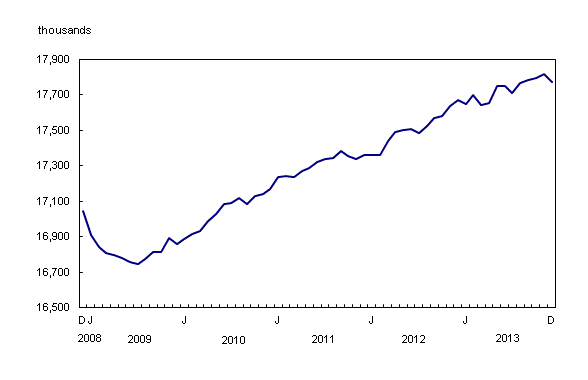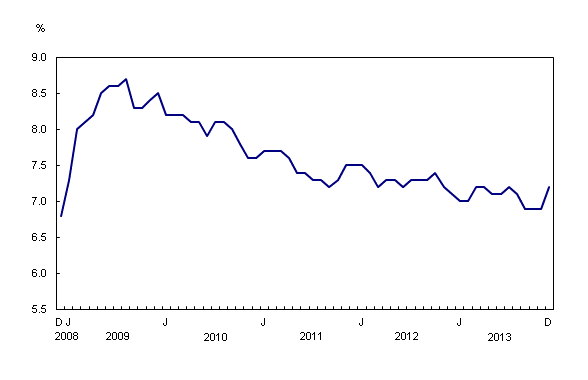Labour Force Survey, December 2013
Archived Content
Information identified as archived is provided for reference, research or recordkeeping purposes. It is not subject to the Government of Canada Web Standards and has not been altered or updated since it was archived. Please "contact us" to request a format other than those available.
Released: 2014-01-10
Employment fell by 46,000 in December, the result of declines in full-time work. The unemployment rate rose 0.3 percentage points to 7.2% as more people searched for work.
Dampened by the decline in December, employment gains in 2013 amounted to 102,000 or 0.6%. Employment growth averaged 8,500 per month in 2013, compared with 25,900 in 2012.
Provincially, employment in December declined in Ontario and Alberta, while it increased in British Columbia and Newfoundland and Labrador.
Nationally, there were fewer people working in educational services, "other services," agriculture as well as natural resources. At the same time, employment increased in health care and social assistance.
In December, self-employment declined, while there was little change among public sector and private sector employees. Compared with 12 months earlier, all the employment gains were among private sector employees.
Fewer men and women aged 25 to 54 were employed in December, while employment increased among women aged 55 and over.
Employment down in Ontario and Alberta
In Ontario, employment fell by 39,000 in December, pushing the unemployment rate up 0.7 percentage points to 7.9%.
The number of people working in Alberta declined by 12,000 in December. However, the unemployment rate was little changed at 4.8% as fewer people participated in the labour market.
In December, there were 13,000 more people working in British Columbia. The unemployment rate in the province was virtually unchanged at 6.6% as more people participated in the labour market.
In Newfoundland and Labrador, employment increased by 1,900 in December, and the unemployment rate fell 1.5 percentage points to 10.8%.
Despite little change in employment in Quebec, the unemployment rate increased 0.5 percentage points to 7.7% as more people looked for work.
Declines in several industries
In December, 19,000 fewer people worked in educational services, offsetting an increase over the previous two months.
There were 15,000 fewer people employed in the "other services" industry, such as personal care services as well as civic and social organizations. Employment also declined in agriculture, down 9,800, and in natural resources, down 8,000.
Health care and social assistance was the only industry with employment gains in December, increasing by 22,000.
Employment losses among 25 to 54 year olds
In December, employment decreased by 38,000 for men and women aged 25 to 54, and their unemployment rate increased 0.4 percentage points to 6.1%.
At the same time, employment rose for women aged 55 and over, up 14,000.
Despite little change in employment among youths aged 15 to 24, the unemployment rate increased 0.6 percentage points to 14.0% as more youths searched for work.
2013: Year-end review
Employment gains in 2013 amounted to 102,000, or 0.6%, the slowest December-to-December growth rate since 2009. In 2012, growth was 310,000 or 1.8% over the 12-month period.
Compared with 12 months earlier, the participation rate declined 0.4 percentage points to 66.4% in December as the labour force grew at a slower pace than the population. Over the same period, the employment rate fell 0.5 percentage points to 61.6%, while the unemployment rate was little changed.
From a provincial perspective, employment growth from December 2012 to December 2013 was fastest in Alberta (+3.3%), with steady gains throughout the year.
Employment rose by 2.5% in Saskatchewan, driven by gains in the first six months of the year. Compared with 12 months earlier, the unemployment rate declined 0.7 percentage points to 3.9%, the lowest among all provinces.
Employment also increased in New Brunswick compared with 12 months earlier, up 1.8%. The unemployment rate declined 1.1 percentage points over the year to 9.7%.
Following a peak at the beginning of the year, employment in Manitoba fell by 1.2% in 2013.
In Ontario, employment gains in the first half of the year were offset by the decline in December, leaving employment little changed compared with 12 months earlier. After trending down throughout most of the year, the unemployment rate increased to 7.9% in December, the same rate as that of December 2012.
Compared with 12 months earlier, employment was virtually unchanged in Quebec. The unemployment rate was also little changed, at 7.7% in December.
Over the 12-month period, employment in Newfoundland and Labrador was little changed. The unemployment rate in this province has gradually declined over the years, averaging 11.4% in 2013, the lowest annual rate recorded since comparable data became available in 1976.
In 2013, the only industries with employment growth were professional, scientific and technical services (+6.7%) and natural resources (+5.7%). At the same time, there were losses in agriculture (-4.5%), educational services (-3.3%), public administration (-3.1%) and manufacturing (-2.3%).
Compared with 12 months earlier, part-time employment grew by 83,000 or 2.5%, while full-time employment was relatively unchanged. During the same period, the number of hours worked increased by 0.7%.
Among the major demographic groups, only men and women aged 55 and over posted employment growth in 2013, up 4.8%, mostly the result of population aging. This segment of the labour force has seen increases in its labour-market participation rate since the mid-1990s, reaching 37.4% in December 2013.
Following a high in December 2012, employment among men aged 25 to 54 declined by 41,000 in December 2013. There was little change in employment among women in the same age group over the same period.
For people aged 15 to 24, both employment and the unemployment rate were little changed compared with December 2012.
Quarterly update for the territories
The Labour Force Survey also collects labour market information about the territories. This information is produced monthly in the form of three-month moving averages. The following data are not seasonally adjusted; therefore, comparisons should only be made on a year-over-year basis.
From the fourth quarter of 2012 to the fourth quarter of 2013, employment in Yukon increased by 900 and the unemployment rate fell from 6.1% to 4.9%.
Over the same period, both employment and the unemployment rate were little changed in the Northwest Territories. In the fourth quarter of 2013, the unemployment rate was 8.2%.
In Nunavut, employment increased by 1,000 in the fourth quarter of 2013, all in full-time work. The unemployment rate was 14.6%, relatively unchanged from the fourth quarter of 2012.
Note to readers
The Labour Force Survey (LFS) estimates are based on a sample and are therefore subject to sampling variability. As a result, monthly estimates will show more variability than trends observed over longer time periods. Estimates for smaller geographic areas or industries also have more variability. For an explanation of sampling variability of estimates and how to use standard errors to assess this variability, consult the "Data quality" section of the publication Labour Force Information (Catalogue number71-001-X).
This analysis focuses on differences between estimates that are statistically significant at the 68% confidence level.
The employment rate is the number of employed persons as a percentage of the population 15 years of age and over. The rate for a particular group (for example, youth aged 15 to 24) is the number employed in that group as a percentage of the population for that group.
The unemployment rate is the number unemployed as a percentage of the labour force (employed and unemployed).
The participation rate is the number of employed and unemployed as a percentage of the population. For more detailed information, see the Guide to the Labour Force Survey (Catalogue number71-543-G).
Unless otherwise stated, this release presents seasonally adjusted estimates, which facilitates comparisons by removing the effects of seasonal variations. For more information on seasonal adjustment, see Seasonal adjustment and identifying economic trends.
Annual revision
Seasonally adjusted estimates from the LFS will be revised using the latest seasonal factors, going back three years (January 2011 onwards). The revised estimates will be available on CANSIM (tables 282-0087 to 282-0094, 282-0100, 282-0116 and 282-0117) on January 31, 2014.
A more detailed summary, Labour Force Information (Catalogue number71-001-X), is now available online for the week ending December 14. From the Browse by key resource module of our website under Publications, choose All subjects, then Labour.
Data tables are also now available online. From the Browse by subject module of our website, choose Labour.
The next release of the Labour Force Survey will be on February 7.
Contact information
For more information, contact us (toll-free 1-800-263-1136; 514-283-8300; infostats@statcan.gc.ca).
To enquire about the concepts, methods or data quality of this release, contact Vincent Ferrao (613-951-4750; vincent.ferrao@statcan.gc.ca) or Lahouaria Yssaad (613-951-0627; lahouaria.yssaad@statcan.gc.ca), Labour Statistics Division.
- Date modified:



